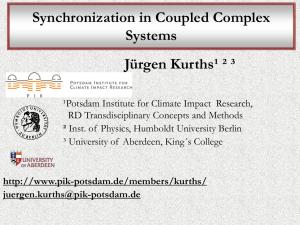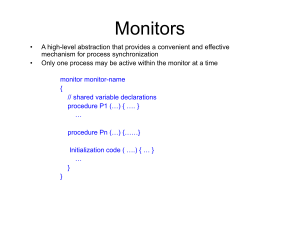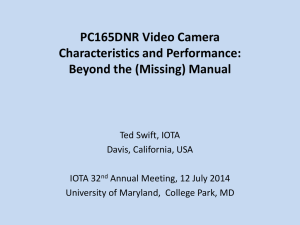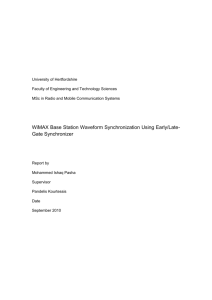Initial Ranging procedure in WiMAX standard
advertisement
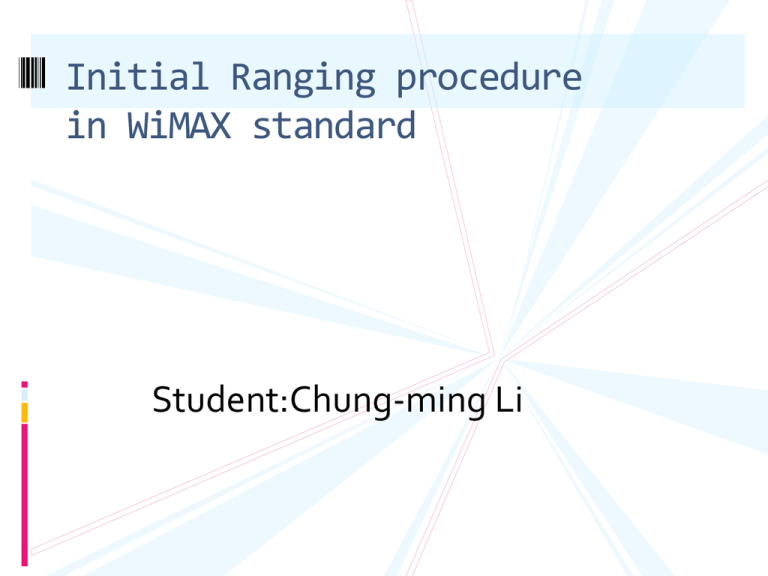
Initial Ranging procedure in WiMAX standard Student:Chung-ming Li Outline Introduction WiMAX frame structure Down-link timing synchronization Initial ranging Timing offset System design conclusion Introduction In OFDMA, it is required that all transmission from MS should arrive BS at the same time. Imagine a cell size of 10Km, we have round trip time of 66.6 us. UL data must arrive BS within 0 to 66.6 us. The whole network synchronization refers to BS clock. Introduction MSs are distributed all over the cell. A MS at cell edge receive data quite late and transmits data very early , being compared with MS close to BS. When a new MS is seeking entry into the network, the MS has no idea as to what time or power should be used for transmitting the initial signal. Introduction This is the BS’s job to detect this new MS. Find the misalignment between the new MS ,and then send response to correct it. The following slides start with a brief description about how WiMAX handles this situation. WiMAX frame structure TTG and RTG are 105.714 μs and 60 μs, respectively. WiMAX frame structure Down-link timing synchronization Initialization AGC Stage DL UL Normal AGC Stage DL DL UL UL 5ms Power-on happens at a random time DL UL DL 5ms 5ms Enable a 5ms counter Measure power Energy detection Yes Several tunes AGC Power on Yes Packet Detection ED AGC Yes AGC PKT Enable a 5ms counter UL t Down-link timing synchronization Oversampling e 4 44.8 50 j 2 2.5(109 )20(106 ) t Channel 50Mhz to 44.8Mhz ADC Mixer AWGN fA/D LO PLL SRRC 4 Down-link timing synchronization SRRC GT ( f ) GR ( f ) G( f ) 4 g[ n] 1 , 2 2 [(1 )sin( )] (1 cos( ))], 4 4 2 sin[ (1 ) (n k ) ] 4 (n k ) cos[ (1 ) (n k ) ] p p p (n k ) (n k ) 2 [1 (4 )] p p 0, for (n k ) 0 for ( n k ) P 4 for n k ( N 1) 2 for n k ( N 1) 2 Down-link timing synchronization Down-link timing synchronization sn N 1 S k 0 k e j 2 kn N if 0, Sk =0, k iM (i interger) k otherwise then sn N 1 S k 0 k e 2 j kn N k 0 j kM k 0 N 1 M S N 1 M e Sn Sn N M 2 kn N M S n Ns X kM e j 2 kMn N N s must be integer !! Down-link timing synchronization Packet detection by cyclic prefix XY cov( X , Y ) XY LCP 1 i 0 LCP 1 E (( X u X ) (Y uY )) E ( X 2 ) E 2 ( X ) E (Y 2 ) E 2 (Y ) rk i rki FFT _ size r i 0 2 k i FFT _ size k is the scanning sample offset FFT_size CP CP Down-link timing synchronization L 1 r k h sk nk , 0 where is thechanneldelay - profilefrom0 to L 1, nk is theAWGN; L 1 r w k f w h s w k n w k f w w 0 w 0 0 W 1 W 1 L 1 W 1 W 1 0 w 0 w 0 h s w k f w n w k f w , where k is the scanning sample offset, Down-link timing synchronization Matched filter is with an eye to maximizing SNR W 1 then n w k f w 0, w 0 if s(w k1 ) f w for k1 0, and E s( w k1 ) f w 0 for k1 0 L 1 W -1 L 1 W -1 L 1 W -1 0 w 0 0 k1 w 0 0 k1 w 0 then h s w k1 f w h s w k1 f w h s w k1 f w L 1 W -1 0 k1 w 0 h f w h k1 2 Down-link timing synchronization 2 L 1 W -1 h f w 0 k1 w0 where k1 0, 2 h k1 , , L 1 2 2 Initial ranging In WiMAX, code division multiple access( CDMA) codes are used to detect new MS. A new MS will transmit one CDMA code. The BS is not only to detect the new MS but also to calculate its timing,frequency and power offset. Initial ranging Code length=144, 256 sets, using BPSK modulation Timing offset Delay Cyclic Prefix Receive Cyclic Prefix data FFT window BS clock j 2 n0k x(n n0 ) e DFT X (k ) Timing offset CDMA Code with phase shift e j 2 n1k X (k ) Signal in x(n n0 ) FFT e j 2 n0k X (k ) e j 2 (n1 n0 )k X (k ) X (k ) 144 j 2 ( n1 n0 ) k e X (k ) X (k ) k 1 For n n0 , and X (k ) X (k ) ,k=1,2,.....144 We get a peak! Timing offset without timing advance with timing advance 21 System Design (105 60) 106 d air 8 2 3 10 d air 6.75 Km Conclusion The BS detects the new MS and calculates the timing offset, then corrects MS transmitting parameters. Taking the round trip time intoconsideration,the maximal cell size should be 6.75 Km.



